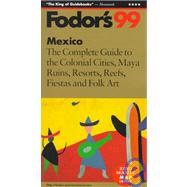
| About Our Writers Each year the Gold Guides are written and updated by more than 500 resident writers | |
| How to Use This Book Describes organization, icons, and other key information | |
| Please Write to Us Tells you how to get in touch with our editors | |
| The Gold Guide: Smart Travel Tips A to Z An easy-to-use section divided alphabetically by topic | |
| Under each listing you'll find tips and information that will help you accomplish what you need to in Mexico | |
| You'll also find addresses and telephone numbers of organizations and companies that offer destination-related services and detailed information and publications | |
| Destination: Mexico Helps get you in the mood for your trip | |
| The Many Faces of Mexico Describes the diverse charm of the country | |
| New and Noteworthy Cues you in on trends and happenings | |
| What's Where Gets you oriented | |
| Pleasures and Pastimes Describes the activities and sights that really make Mexico unique | |
| Fodor's Choice Showcases our top picks from special restaurants and one-of-a-kind accommodations to out-of-the-ordinary sights and activities... | |
| Let them inspire you! Festivals and Seasonal Events Alerts you to special Mexican events you'll want to seek out | |
| The following chapters in Fodor's Mexico '99 are arranged geographically | |
| Each city chapter begins with an Exploring section subdivided by neighborhood; each subsection recommends a walking or driving tour and lists sights in alphabetical order | |
| Each regional chapter is divided by geographical area | |
| Within each area, towns are covered in logical geographical order, and within town sections, all restaurants and lodgings are grouped together | |
| Attractive stretches of road and minor points of interest between towns appear in En Route subsections | |
| Off the Beaten Path sights appear after the places from which they are most easily accessible | |
| To help you decide what to visit in the time you have, all chapters begin with our recommended itineraries | |
| The A to Z section that ends all chapters covers getting to and around the area in question | |
| It also provides helpful contacts and resources | |
| Mexico City Baja California Sonora The Copper Canyon: From Los Mochis to Chihuahua City Pacific Coast Resorts Guadalajara The Heartland of Mexico With San Miguel de Allende, Guanajuato, Zacatecas, Querétaro, Morelia, and Pátzcuaro | |
| Acapulco Oaxaca Chiapas and Tabasco With San Cristóbal de las Casas, South and East of San Cristóbal, North and West of San Cristóbal, The Road to Palenque and Beyond, and Villahermosa and Tabasco | |
| Northeastern Mexico and Veracruz The Yucatán Peninsula With Cancún, Isla Mujeres, Cozumel, The North Caribbean Coast, the State of Yucatán, and the State of Campeche | |
| Portraits of Mexico The story of Mexico's turbulent and fascinating history, followed by suggestions for pretrip reading | |
| Spanish Vocabulary A helpful guide to essential words and phrases | |
| Index List of 62 Maps | |
| Table of Contents provided by Publisher. All Rights Reserved. |
The New copy of this book will include any supplemental materials advertised. Please check the title of the book to determine if it should include any access cards, study guides, lab manuals, CDs, etc.
The Used, Rental and eBook copies of this book are not guaranteed to include any supplemental materials. Typically, only the book itself is included. This is true even if the title states it includes any access cards, study guides, lab manuals, CDs, etc.
Excerpted from Mexico '99: The Complete Guide to the Colonial Cities, Maya Ruins, Resorts, Reefs, Fiestas and Folk Art by Fodor's Travel Publications, Inc. Staff
All rights reserved by the original copyright owners. Excerpts are provided for display purposes only and may not be reproduced, reprinted or distributed without the written permission of the publisher.